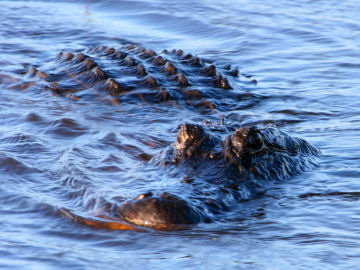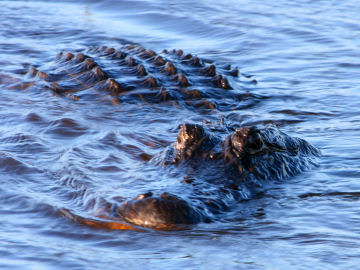Diving, rolling and floating, alligator style
Try to wrestle an alligator submersed, and you'll belik lose. It's non just that the norm gator—at 11 feet long and close to 1,000 pounds—is a whole lot bigger than you are. IT turns tabu alligators have a secret artillery when it comes to kinetic upward, inoperative, and around in the water system. Nobody recognized it until now, simply alligators really prompt their lungs to helper them diving, surface, and roll.
A team of scientists at the University of Utah in Sharp Lake City recently discovered that alligators use their breathing muscles for a 2nd job: to shift their lungs around inside of their trunk. This helps the animals move up and down in water away allowing them to control their buoyancy, operating theatre which parts of them float and which parts sink. To nose dive, they wring their lungs toward their tail. This tips a alligator's head down and prepares it to soak up. To surface, the alligators move their lungs towards their head. And to roll? They use muscles to press their lungs sideways.
 |
| Alligators use muscles to pull their lungs in different directions. Moving the position of their lungs helps alligators contain their buoyancy, or the way they float in the water. This control helps them move smoothly through piss, researchers allege. |
| L.J. Guillette, University of Florida |
"The big picture is that lungs are probably more than just breathing machines," says T.J. Uriona. He's a graduate educatee and one of the scientists from Utah who discovered how alligators use muscles to incite their lungs.
Alligators have some breathing muscles that people get into't have. A heroic heftines connects the alligator's liver to the bones at its hips. When this muscle pulls the liver down and towards the tail, the lungs produce extended down too. Then, more aura flows into the lungs. And when the sinew relaxes, the liver slides up and the lungs pay off squeezed, pushing air out.
What's puzzling is that when this liver-to-hips muscle doesn't work, alligators stool still breathe healthy. That LED Uriona and his co-worker C.G. Farmer to first subject area how alligators power use this and else muscle groups surrounding their lungs.
To test these muscular tissue groups, the researchers set electrodes in the muscles of a chemical group of youngish alligators. Electrodes are tools scientists can use to measure the electrical signals that muscles make when they running. The electrodes showed that alligators clench four groups of muscles when they dive. These let in the muscles that pull the lungs back and toward the plover-like's tail when they tighten.
That finding was what made Uriona wonderment whether pull the lungs second helps the alligator dive into the water.
To find out, he and Farmer taped lead weights to the animals' tails. This made it harder for the animals to dive nose first. The electrodes showed that with weight added to their tailcoat, the muscles needed to bring on true harder to pull the lungs far back toward the tail.
What would happen if the weights were instead taped to the animals' noses? Adding weight to the advance of the body should pretend a downward dive easier than adding free weight to the back of the body. And that's just what the electrodes showed. The muscle groups didn't have to work A hard.
And for a peal alligator? Information from the electrodes showed the breathing muscles on only indefinite side of the body tightened. The muscles on the other side remained relaxed. This squeezed the lungs to one side of the body, making that slope rise in the water supply.
Unlike aquatic animals comparable fish and seals, alligators don't have fins surgery flippers to help them move smoothly in the water. But somehow, they soundless handle to sneak up mutely on prey while moving through the body of water.
Uriona says using the lungs for motion might have evolved American Samoa a way for gators to surprisal unsuspecting prey. "It allows them to sail a watery environment without creating a lot of disturbance," he says. "This is probably really important when they are trying to creep up on an animal only they don't want to produce ripples."
Power Words
From The American Inheritance® Student Science Lexicon, The American Inheritance® Children's Skill Dictionary, and different sources.
electrode A piece of C or antimonial through which an electric underway can recruit or forget an electric device. Batteries have two electrodes, cocksure and negative.
buoyancy The upward drive on an object floating in a limpid or gas. Buoyancy allows a sauceboat to float on water.

Copyright © 2002, 2003 Houghton-Mifflin Company. All rights reserved. Used with permission.
Going Deeper:
Milius, Susan. 2008. Alligator aids: Gators squish lungs or so to dive and roll. Science News 173(March 15):164-165. Accessible at http://web.sciencenews.org/articles/20080315/fob5.asp .

0 Response to "Diving, rolling and floating, alligator style"
Post a Comment